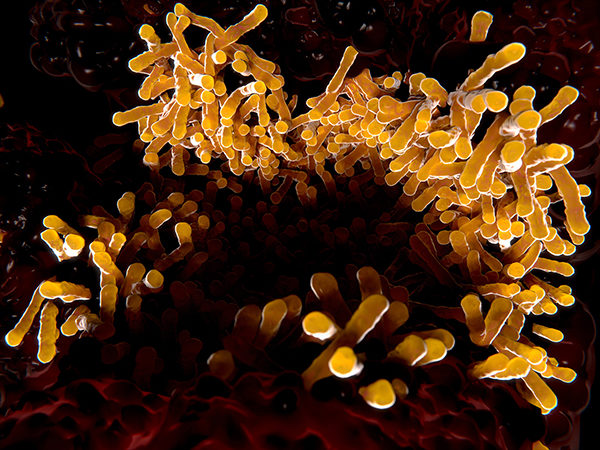Calling for the use of broad-spectrum antibiotics can be as indiscriminate as saying, “Kill them all; let God sort them out.” Either way, one may eliminate the good along with the bad, courting blowback, that is, repercussions that are as unwelcome as they are unpredictable. When the good include commensal bacteria, blowback may include antibiotic-associated dysbiosis, the development of secondary infections that wouldn’t have occurred otherwise, and additional opportunities for the development of antibiotic resistance.
To avoid bacterial blowback, scientists at Penn State are working on pathogen-specific antimicrobials, peptides that work like molecular smart bombs. Recently, the scientists introduced a peptide that they say has been engineered to target Mycobacterium tuberculosis.
Details about the new peptide appeared in the journal Nature Biomedical Engineering, in an article titled, “Pathogen-specific antimicrobials engineered de novo through membrane-protein biomimicry.” The article explains that the peptide can target M. tuberculosis—while sparing commensal bacteria and host tissue—because it mimics key molecular features of the pathogen’s channel-forming membrane proteins.
“By exploiting physical and structural vulnerabilities within the pathogen’s cellular envelope, we designed a peptide sequence that undergoes instructed tryptophan-zippered assembly within the mycolic acid-rich outer membrane of M. tuberculosis,” the article’s authors wrote. “These mycomembrane-templated assemblies elicit rapid mycobactericidal activity and enhance the potency of antibiotics by improving their otherwise poor diffusion across the rigid M. tuberculosis envelope with respect to agents that exploit transmembrane protein channels for antimycobacterial activity.”
The development of the new peptide was led by Scott H. Medina, PhD, an assistant professor of biomedical engineering. “One of the best protective mechanisms we have to prevent infection are beneficial bacteria that inhabit our bodies, known as commensals,” he said. “For example, we often avoid food poisoning because our guts are already populated by helpful bacteria.
“There’s no room for the pathogen to take hold and colonize. If you wipe out the good bacteria, opportunistic pathogens can take advantage and cause infections.”
Medina and colleagues, including biomedical engineering doctoral student Andrew W. Simonson, chose to test their targeting strategy on the pathogen that causes tuberculosis (TB), one of the top 10 causes of death worldwide. “There are great control strategies and treatments in place for tuberculosis, making it largely preventable and treatable,” noted Medina, “but drug-resistant TB is an emerging threat that is on track to becoming a serious global health problem. It’s a scary prospect.”
To develop a pathogen-specific antibacterial against TB, the researchers looked to the pathogen itself. The TB pathogen is wrapped in a thick envelope that is difficult to penetrate, especially compared to other bacteria.
“The envelope has pores, though—channels through which the pathogen takes in nutrients and metabolites,” Medina detailed. “We asked if we could mimic these channels to design antibacterials that would create holes in the bacterial envelope, and ultimately kill the pathogen.”
The researchers made a peptide that seems to disrupt the protective outer coating of the pathogen, making the TB bacteria susceptible to antibiotics and die, but it does not interact with the good bacteria. Medina said they are currently studying the exact mechanism by which the peptide attacks the TB pathogen, but they suspect it has something to do with a fatty acid that lives on the pathogen’s surface.
“There aren’t many biochemical differences between the targeted pathogen and good bacteria, except for this surface lipid,” Medina noted. “We think the interaction of our peptide with this fatty acid is one of the things driving this preferential interaction.”
He also pointed to the bacteria’s thin carbohydrate region. In other types of bacteria, the carbohydrates form a thick defensive barrier that appears to insulate the bacteria against the peptide.
“It’s not entirely clear why this works, but it’s working on TB,” Medina declared. “There’s a 10-fold improvement on the effectiveness of antibiotics on this pathogen relative to the other good bacteria.”
Next, the researchers plan to investigate how to administer the peptide to treat TB in a full model system. Peptides tend to break down when injected, Medina said, so his team is working to develop an aerosol that would allow a person to inhale the peptides directly to the infected lung tissue.
“Once we understand why this peptide targets TB, and how to administer the peptide as a viable therapeutic, we can use this platform to design antibacterials toward other lung pathogens,” Medina said.


